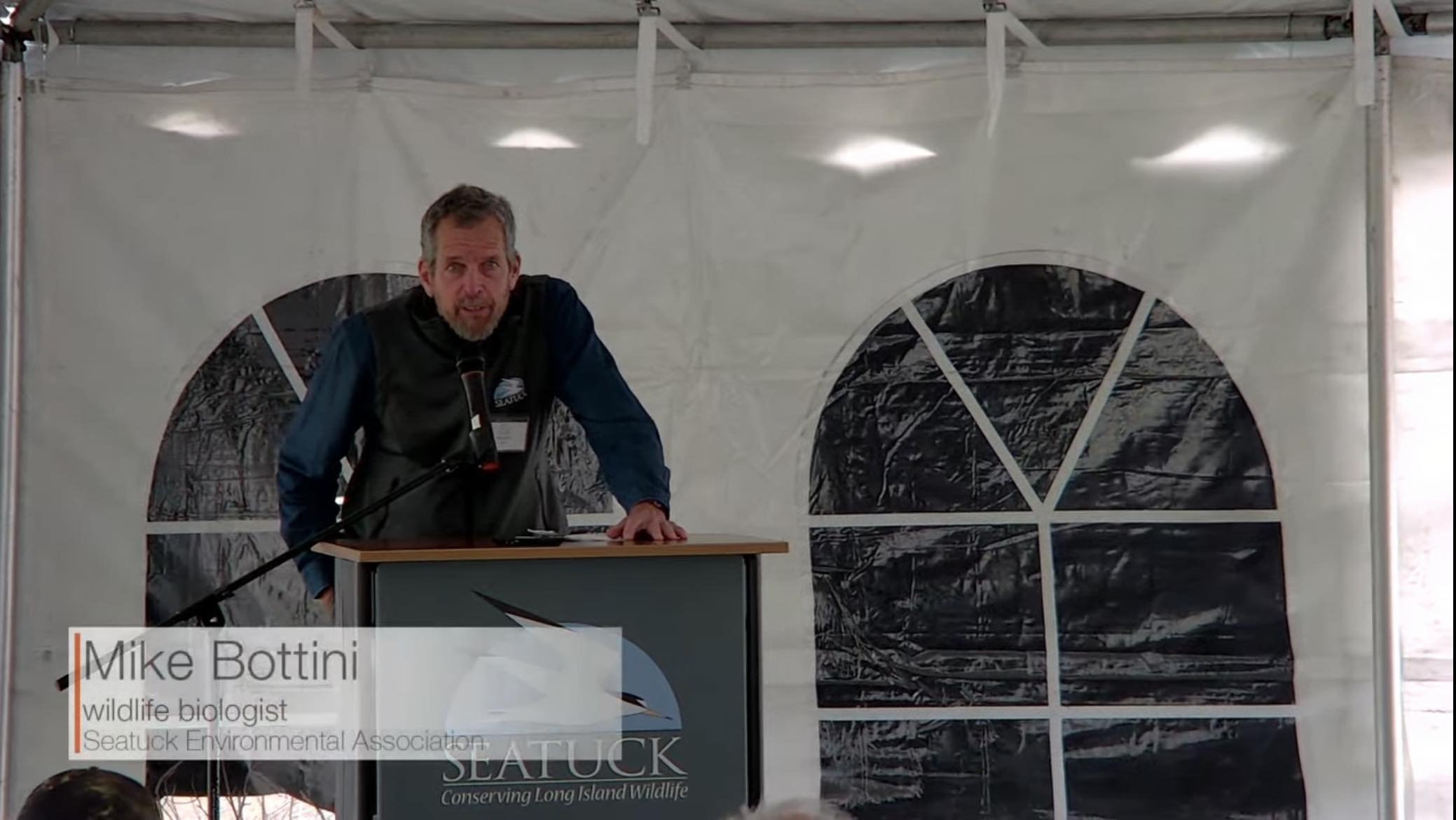The 2023 Long Island Natural History Conference held at the Suffolk County Environmental Center on Friday, April 28 attracted a coalition of scientists, environmentalists, naturalists, and interested members of the public to discuss new developments in Long Island ecological research and environmentalism. It was the first time the conference has been held since 2019.

Caption: Mike Bottini, a wildlife biologist with the Seatuck Environmental Association, speaking at the 2023 Long Island Natural History Conference.
According to Enrico Nardone, the Executive Director of the Seatuck Environmental Association, just under 300 attendees gathered for the conference in person while an additional 100 registered to watch the proceedings remotely. The event was hosted by the Seatuck Environmental Association and co-sponsored by numerous local and national environmental organizations and businesses listed on the conference’s website. Nardone referred to the event as a “family reunion” for the Long Island environmental community.
Seven feature presentations and seven shorter “conservation updates” on topics discussed during previous Long Island natural history conferences were presented. The topics of the featured presentations included a survey of terrestrial mammals that the public can participate in, efforts to reestablish scallop fisheries, a study on the diet of Nassau County coyotes, a study of salt marsh health in the face of climate change, and more. While the conservation updates covered offshore wind development, vernal pool conservation, whale strandings, the ongoing colonization of Long Island by coyotes and river otters, and efforts to preserve rare turtle and fish species among other topics.
One conservation update on the movement to turn Plum Island into a national monument put out a call for members of the public to contact President Joe Biden to urge him to act to protect the federally owned island. According to Louise Harrison, the Long Island Natural Areas Manager of an environmental group called Save the Sound, the island is a habitat for 228 bird species and an important wintering ground for seals. President Biden has the power to declare national monuments on federal lands and waters under the Antiquities Act. Save The Sound has set up a portal on their website where members of the public can send an email to the White House urging Biden to set aside Plum Island as a national monument.
Many of the presentations offered unique scientific insights into important local conservation issues. For instance, Casey Pendergast, a Threatened & Endangered Species Biologist with New York State Department of Environmental Conservation, remotely presented her research on the effects of White Nose Syndrome on coastal populations of northern long-eared bats through a prerecorded video. White Nose Syndrome is an invasive fungal disease devastating bat populations. The endangered northern long-eared bat, featured in this study has experienced a 99% decrease in their numbers within the Northeast but populations living on Long Island, Martha’s Vineyard, and Nantucket have been more resistant to this decline. Pendergast’s study concluded that this is because the milder coastal climate of these areas allows the bats to feed on insects even during the winter giving them the energy to fight off the disease. These findings demonstrate preserving northern long-eared bats on Long Island will be very important for the sake of the species overall survival.
Another presentation, given by Greentree Foundation Naturalist Stephane Perreault, explained the diet and behavior of a mated pair of eastern coyotes living on a private nature preserve in Manhasset owned by the Greentree Foundation. The research used trail cameras and examinations of coyote scat on the property to glean information about their lives and diets over the course of three years. While the results of this particular study may not be representative of Long Island coyotes in general, they do offer researchers a window into the lives of these wild canines. The largest single animal food item consumed by the coyotes was racoon followed by vole, grey squirrel, and eastern cottontail rabbit. Fruits and seeds were also major food items for the animals. Coyotes were also recorded eating the carcass of one white-tailed deer over several nights during the study but the animal was not a primary source of food for the coyotes living on the Greentree property. The results may call into question hopes that coyotes could help control the Long Island deer population, though the diet mix of the Manhasset coyotes may not be representative of coyotes elsewhere. It should also be noted that no feline remains were detected in the coyote scat despite numerous feral cats being present in the preserve.
The Long Island Natural History Conference was founded in 2012 by Mike Botitini, John Turner, and Jim Monaco in order to build connections within the Long Island environmental community, highlight management needs, and foster a greater interest in the region’s natural history among the public. The event has been held eight times and went on hiatus during the pandemic. Nardone explained this history and said the event will be held again next April. He also had a message for Long Islanders who missed this year’s conference: “We want as many people as we can to participate. Both in person and online, stay tuned and make plans to join us next year.” The lectures from this year’s conference are scheduled to be uploaded to the Seatuck Environmental Association website within a few weeks. Lectures from previous iterations of the conference are already available to be viewed by the public and can be found on their website.































